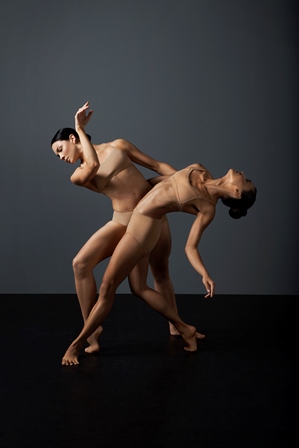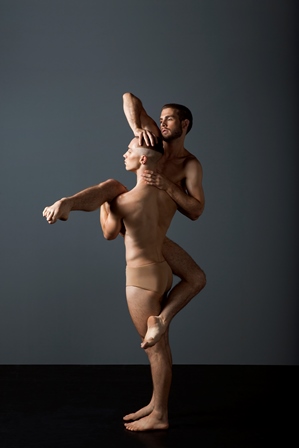3o August 2013, Studio Theatre, Sydney Opera House
With his latest program, Les Illuminations, Sydney Dance Company’s Rafael Bonachela has given audiences a new look at his spectacular dancers. This is an intimate program, made so by its venue, the Studio at the Sydney Opera House, and by its setting within that venue. The program, which consists of two short pieces both to music by Benjamin Britten, Simple Symphony and Les Illuminations, is danced on a T-shaped catwalk with the audience seated in the round. On the cross bar of the ‘T’ sits a string ensemble of musicians from the Sydney Symphony Orchestra. They are joined in the second part by singer Katie Noonan, who sings the soprano role in Les Illuminations. The dancers perform entirely on the long line of the T.
What struck me instantly as Simple Symphony began was that Bonachela was taking advantage of the restricted performance space and was using more high lifts than usual. ‘Boisterous Bourrée’, the opening duet danced by Janessa Dufty and Andrew Crawford, began with a kind of ‘presage’ lift and continued with some gorgeous partnering, including more lifts. These two dancers set up a lovely partnership not only by dancing so well but also through their emotional connection with each other. Touch, glances, head movements, all played a part in making this duet a wonderful opener. The third part, ‘Sentimental Sarabande’ also stood out for its strong and emotionally engaging dancing by Fiona Jopp and Bernhard Knauer. With Toni Maticevski’s close fitting, light coloured costumes, decorated with pale turquoise trimmings, and the often playful moments in the choreography, Simple Symphony reminded me of a pastoral romp.
There was nothing pastoral about the second section of the program, Les Illuminations. This was a darker side of life and featured just four dancers once more—Juliette Barton, Charmene Yap, Thomas Bradley and Cass Mortimer Eipper. The title Les Illuminations relates to a poem written by the Frenchman Arthur Rimbaud and the choreography seemed to me to have many elements that characterise Symbolism, a movement in the arts that was ‘in the air’ at the time when Rimbaud and his lover Paul Verlaine were writing. Ideas were suggested as dancers prowled around their long, narrow space casting telling glances at each other. Nothing seemed obvious. Maticevski’s costumes, this time sleeveless bodysuits in black with the addition of a black feathered headdress worn by Barton and a black face mask worn by Bradley, suggested a kind of decadence to me, again part of the Symbolist mood.
This second part of the program was certainly striking and as ever beautifully danced but I’m just not sure that the ideas that Rimbaud was writing about can be well portrayed through the medium of dance. It did, however, set up an effective contrast with Simple Symphony.
Michelle Potter, 1 September 2013.
NOTE: A dance work to Simple Symphony was first seen in Australia in October 1947 during a tour by Ballet Rambert. That version was choreographed by Walter Gore. Gore’s Simple Symphony was filmed in Brisbane (outdoors, or at least partly outdoors, if I remember correctly from watching the film some years ago) in 1948. Here is the National Film and Sound Archive’s catalogue record. Although of course Bonachela’s Simple Symphony is quite, quite different, it makes a nice tie-in with the Gore production, given Bonachela’s connections with Rambert Dance.


One thought on “Les illuminations. Sydney Dance Company”